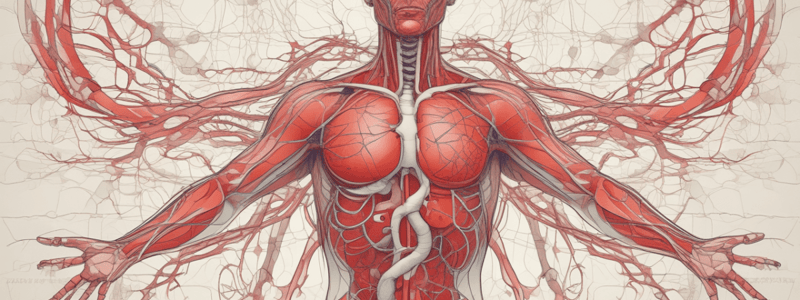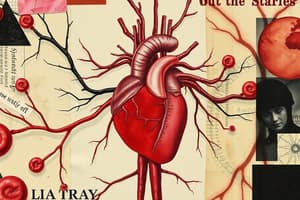Podcast
Questions and Answers
What is the primary causative agent of acute bacterial endocarditis?
What is the primary causative agent of acute bacterial endocarditis?
- Staphylococci
- S.aureus (correct)
- Alpha hemolytic Streptococci
- Enterococci
Which symptom is NOT typically associated with bacterial endocarditis?
Which symptom is NOT typically associated with bacterial endocarditis?
- New heart murmur
- Cough
- Fatigue
- Dry skin (correct)
In which group of individuals is the risk for developing acute endocarditis higher?
In which group of individuals is the risk for developing acute endocarditis higher?
- Individuals with high blood pressure
- Individuals with a healthy heart
- Individuals with renal failure
- Individuals with a damaged heart valve (correct)
Which of the following is a common diagnostic method for endocarditis?
Which of the following is a common diagnostic method for endocarditis?
What is a possible outcome of untreated acute endocarditis?
What is a possible outcome of untreated acute endocarditis?
What is the typical treatment duration for severe cases of bacterial endocarditis?
What is the typical treatment duration for severe cases of bacterial endocarditis?
Which bacteria is most commonly associated with sub-acute bacterial endocarditis?
Which bacteria is most commonly associated with sub-acute bacterial endocarditis?
What process occurs after a damaged valve accumulates clots in bacterial endocarditis?
What process occurs after a damaged valve accumulates clots in bacterial endocarditis?
Which symptom is commonly seen in both acute and sub-acute bacterial endocarditis?
Which symptom is commonly seen in both acute and sub-acute bacterial endocarditis?
Which of the following antibiotics is NOT included in the acute treatment for a prosthetic heart valve?
Which of the following antibiotics is NOT included in the acute treatment for a prosthetic heart valve?
What is the causative agent of the plague?
What is the causative agent of the plague?
What symptom is characteristic of bubonic plague?
What symptom is characteristic of bubonic plague?
Which statement about the pneumonic plague is true?
Which statement about the pneumonic plague is true?
Which of the following might require valve replacement surgery?
Which of the following might require valve replacement surgery?
Which high-risk group has the highest rates of plague cases?
Which high-risk group has the highest rates of plague cases?
What is a common treatment for plague infections?
What is a common treatment for plague infections?
How does Yersinia pestis evade the immune response?
How does Yersinia pestis evade the immune response?
Which of the following statements about the plague vaccine is true?
Which of the following statements about the plague vaccine is true?
What components are included in the closed system of flow to and from the heart?
What components are included in the closed system of flow to and from the heart?
Which of the following is NOT a layer of the heart?
Which of the following is NOT a layer of the heart?
What is the most common cause of sepsis in hospital admissions?
What is the most common cause of sepsis in hospital admissions?
How is septicemia characterized in terms of bacterial activity?
How is septicemia characterized in terms of bacterial activity?
Which type of cells are found in lymph nodes and are crucial for immune response?
Which type of cells are found in lymph nodes and are crucial for immune response?
Which of the following is a key symptom of sepsis?
Which of the following is a key symptom of sepsis?
What form of treatment is typically administered for septicemia?
What form of treatment is typically administered for septicemia?
Which of the following is a potential complication of septicemia?
Which of the following is a potential complication of septicemia?
What is the primary component of lymph derived from blood?
What is the primary component of lymph derived from blood?
What is the causative agent of Lyme disease?
What is the causative agent of Lyme disease?
What is the primary risk factor for contracting Lyme disease?
What is the primary risk factor for contracting Lyme disease?
Which symptom is associated with Lyme disease and occurs in 70-80% of cases?
Which symptom is associated with Lyme disease and occurs in 70-80% of cases?
How long must a tick feed to transmit Lyme disease?
How long must a tick feed to transmit Lyme disease?
Which statement is true regarding anthrax transmission?
Which statement is true regarding anthrax transmission?
What type of organism is Bacillus anthracis?
What type of organism is Bacillus anthracis?
Which of the following is NOT a form of anthrax?
Which of the following is NOT a form of anthrax?
What is a common long-term effect of Lyme disease that may develop weeks to months after infection?
What is a common long-term effect of Lyme disease that may develop weeks to months after infection?
What type of organism primarily serves as a reservoir for Lyme disease?
What type of organism primarily serves as a reservoir for Lyme disease?
Which virulence factor of anthrax is responsible for local swelling and interferes with phagocytosis?
Which virulence factor of anthrax is responsible for local swelling and interferes with phagocytosis?
What is the fatality rate of untreated gastrointestinal anthrax?
What is the fatality rate of untreated gastrointestinal anthrax?
In which region of the United States are most cases of Rocky Mountain Spotted Fever reported?
In which region of the United States are most cases of Rocky Mountain Spotted Fever reported?
What is the primary mechanism by which Epstein-Barr Virus (EBV) can lead to lymphomas?
What is the primary mechanism by which Epstein-Barr Virus (EBV) can lead to lymphomas?
Which of the following treatments is considered effective for cutaneous anthrax?
Which of the following treatments is considered effective for cutaneous anthrax?
What is the incubation period for infectious mononucleosis caused by EBV?
What is the incubation period for infectious mononucleosis caused by EBV?
Which of the following symptoms is NOT commonly associated with inhalation anthrax?
Which of the following symptoms is NOT commonly associated with inhalation anthrax?
What is the most effective method for preventing Rocky Mountain Spotted Fever?
What is the most effective method for preventing Rocky Mountain Spotted Fever?
Which of the following classes of antibiotics is NOT used to treat anthrax infections?
Which of the following classes of antibiotics is NOT used to treat anthrax infections?
Flashcards are hidden until you start studying
Study Notes
Cardiovascular and Lymphatic Systems
- Heart is located within the pericardium, composed of three layers: endocardium (interior), myocardium (middle), and epicardium (outer).
- Closed circulatory system facilitates the flow of gases, nutrients, and lymphocytes to and from the heart.
- Blood consists of water, proteins, and cells, while lymph is derived from blood and contains proteins and lymphocytes traveling through lymph vessels to nodes.
Bacterial Infections
- Bacteremia & Septicemia: Presence of bacteria/toxins in the blood; septicemia involves toxin-producing and multiplying bacteria, leading to systemic infections.
- Sepsis occurs in 2% of hospital admissions; inflammation becomes harmful, commonly resulting from pneumonia.
- Causative agents include Streptococci and Staphylococci, often acquired nosocomially.
- Signs/Symptoms of Sepsis: Lymphangitis, shock, confusion, blood-clotting abnormalities, and organ shutdown.
- Diagnosis performed through blood cultures; treatment generally involves IV antibiotics like penicillin or vancomycin.
Acute & Subacute Bacterial Endocarditis
- Infection of the endocardium and/or heart valves, can manifest acutely or subacutely based on onset speed.
- High-risk groups include individuals with damaged or artificial heart valves; acute endocarditis commonly caused by Staphylococcus aureus.
- Symptoms include fatigue, fever, anemia, joint pain, and potential for skin rashes.
- Diagnosis methods include blood cultures and echocardiograms; treatment requires high-dose IV antibiotics for 4-6 weeks.
Plague
- Historically significant pandemics: Justinian plague, Black Death, Orientalis outbreak in the late 19th century.
- In the U.S., 1-40 cases reported annually, primarily affecting Native Americans and those in contact with infected animals.
- Causative agent Yersinia pestis, a Gram-negative rod; spreads through bites or inhalation of infected material.
- Bubonic plague: Lymphatic system infection leading to swollen lymph nodes (buboes), can progress to pneumonic form.
- Treatment options include tetracycline and streptomycin; vaccine available but not for immediate protection.
Lyme Disease
- First identified in 1977, with over 25,000 cases reported in the U.S. in 2014; caused by Borrelia burgdorferi, a Gram-negative spirochete.
- Primarily transmitted by ticks, requiring a minimum of 36 hours of attachment for effective transmission.
- Symptoms include characteristic bull's-eye rash and joint pain; can develop cardiac and neurological effects.
Anthrax
- Caused by Bacillus anthracis, a Gram-positive endospore-forming bacterium, predominantly affects herbivorous animals.
- Three primary forms: cutaneous, gastrointestinal, and respiratory, with specific transmission routes for each.
- Cutaneous anthrax is the most common, with distinctive ulceration and significant mortality without treatment.
- Gastrointestinal and inhalation forms are more severe, with high fatality rates even with treatment.
Rocky Mountain Spotted Fever
- Caused by Rickettsia rickettsii, primarily transmitted by the dog tick; most cases are reported in the Southeastern U.S.
- Symptoms typically arise one week post-bite, including headache, fever, nausea, and rash, with possible joint pain.
- Treatment generally involves doxycycline; mortality rates can vary significantly based on strain strength.
Viral Cardiovascular and Lymphatic Diseases
- Notable diseases include Infectious Mononucleosis (caused by Epstein-Barr Virus), Ebola Virus Hemorrhagic Fever, and West Nile Fever.
- Infectious mononucleosis typically spreads through saliva and results in fatigue, sore throat, and swollen lymph glands, notably impacting B cells, leading to potential complications such as Hodgkin’s and Burkitt’s lymphoma.
Summary
- Understanding the nuances of various diseases affecting the cardiovascular and lymphatic systems supports better diagnosis, treatment, and prevention strategies.
- Critical to address risk factors, transmission methods, and treatment approaches to manage these diseases effectively.
Studying That Suits You
Use AI to generate personalized quizzes and flashcards to suit your learning preferences.




